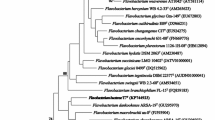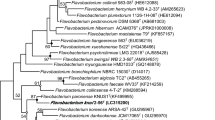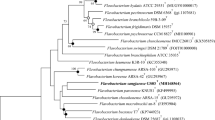Abstract
A Gram-stain-negative, rod-shaped, aerobic and non-motile bacterium, designated P2-65T, was isolated from Moonsan stream water in the Republic of Korea. The temperature, NaCl concentration and pH ranges for growth of strain P2-65T were 10–37 °C, 0.0–3.0% (w/v) and 6.5–8.5 with optimum growth at 25–30 °C, 0.0–1.0% and 7.0–7.5, respectively. Comparison of 16S rRNA gene sequence showed that strain P2-65T was closely related to Flavobacterium cauense (95.4%) and Flavobacterium cheniae (95.3%). The major fatty acids were iso-C15:0, iso C17:0 3-OH, summed feature 3 (C16:1ω7c and/or C16:1ω6c), summed feature 9 (iso-C17:1 ω9c and/or 10-methyl C16:0) and iso-C15:0 3-OH. The predominant respiratory quinone was menaquinone-6 (MK-6). The major polar lipids detected in the strain were phosphatidylethanolamine, one aminophospholipid, one unidentified aminolipid and one unidentified polar lipid. The G + C content of the genomic DNA was 39.7%. The average nucleotide identity (ANI) and digital DNA–DNA hybridization (dDDH) values for strain P2-65T with closely related Flavobacterium species were below 74.8% and 20%, respectively. Based on polyphasic features, strain P2-65T is considered to represent a novel species of the genus Flavobacterium, for which the name Flavobacterium inviolabile sp. nov. is proposed. The type strain is P2-65T (= KCTC 62055T = NBRC 112953T).

Similar content being viewed by others
Abbreviations
- KCTC:
-
Korean Collection for Type Cultures
- NBRC:
-
NITE Biological Resource Center
- R2A:
-
Reasoner’s 2A
- TSA:
-
Tryptone soy agar
- NA:
-
Nutrient agar
- LB:
-
Luria–Bertani
- PDA:
-
Potato dextrose agar
- PGAP:
-
Prokaryotic Genome Annotation Pipeline
- RAST:
-
Rapid Annotation using Subsystem Technology
- ANI:
-
Average Nucleotide Identity
- dDDH:
-
Digital DNA–DNA hybridization
- GGDC:
-
Genome-to-Genome Distance Calculator
- CDSs:
-
Coding sequences
- AL:
-
Aminolipid
- APL:
-
Aminophospholipid
- PE:
-
Phosphatidylethanolamine
- PL:
-
Phospholipid
- UL:
-
Unidentified lipid
References
Bauer AW, Kirby WM, Sherris JC, Turck M (1966) Antibiotic susceptibility testing by a standardized single disk method. Am J Clin Pathol 45:493–496. https://doi.org/10.1093/ajcp/45.4_ts.493
Bergey DH, Harrison FC, Breed RS et al (1923) Bergey’s manual of determinative bacteriology. Williams & Wilkins, Baltimore
Bernardet JF, Nakagawa Y, Holmes B (2002) Proposed minimal standards for describing new taxa of the family Flavobacteriaceae and emended description of the family. Int J Syst Evol Microbiol 52:1049–1070. https://doi.org/10.1099/00207713-52-3-1049
Chaudhary DK, Kim DU, Kim D, Kim J (2019) Flavobacterium petrolei sp. nov., a novel psychrophilic, diesel-degrading bacterium isolated from oil-contaminated Arctic soil. Sci Rep 9:4134. https://doi.org/10.1038/s41598-019-40667-7
Felsenstein J (1981) Evolutionary trees from DNA sequences: a maximum likelihood approach. J Mol Evol 17:368–376. https://doi.org/10.1007/BF01734359
Kates M (1972) Techniques of lipidology. Elsevier, New York
Kumar S, Stecher G, Tamura K (2016) MEGA7: molecular evolutionary genetics analysis version 7.0 for bigger datasets. Mol Biol Evol 33:1870–1874. https://doi.org/10.1093/molbev/msw054
Kumru S, Tekedar HC, Blom J, Lawrence ML, Karsi A (2020) Genomic diversity in flavobacterial pathogens of aquatic origin. Microb Pathog 142:104053. https://doi.org/10.1016/j.micpath.2020.104053
Kuo I, Saw J, Kapan DD et al (2013) Flavobacterium akiainvivens sp. nov., from decaying wood of Wikstroemia oahuensis, Hawai’i, and emended description of the genus Flavobacterium. Int J Syst Evol Microbiol 63:3280–3286. https://doi.org/10.1099/ijs.0.047217-0
Kwak MJ, Kong HG, Choi K et al (2018) Rhizosphere microbiome structure alters to enable wilt resistance in tomato. Nat Biotechnol 36:1100–1109. https://doi.org/10.1038/nbt.4232
Lee I, Kim YO, Park SC, Chun J (2016) OrthoANI: an improved algorithm and software for calculating average nucleotide identity. Int J Syst Evol Microbiol 66:1100–1103. https://doi.org/10.1099/ijsem.0.000760
Meier-Kolthoff JP, Auch AF, Klenk HP, Göker M (2013) Genome sequence-based species delimitation with confidence intervals and improved distance functions. BMC Bioinform 14:60. https://doi.org/10.1186/1471-2105-14-60
Minnikin DE, O’Donnell AG, Goodfellow M et al (1984) An integrated procedure for the extraction of bacterial isoprenoid quinones and polar lipids. J Microbiol Meth 2:233–241. https://doi.org/10.1016/0167-7012(84)90018-6
Oren A, Duker S, Ritter S (1996) The polar lipid composition of Walsby’s square bacterium. FEMS Microbiol Lett 138:135–140. https://doi.org/10.1111/j.1574-6968.1996.tb08146.x
Overbeek R, Olson R, Pusch GD et al (2014) The seed and the rapid annotation of microbial genomes using subsystems technology (RAST). Nucleic Acids Res 42:D206–D214. https://doi.org/10.1093/nar/gkt1226
Poi G, Shahsavari E, Aburto-Medina A, Mok PC, Ball AS (2018) Large scale treatment of total petroleum-hydrocarbon contaminated groundwater using bioaugmentation. J Environ Manag 214:157–163. https://doi.org/10.1016/j.jenvman.2018.02.079
Richter M, Rosselló-Móra R (2009) Shifting the genomic gold standard for the prokaryotic species definition. Proc Natl Acad Sci USA 106:19126–19131. https://doi.org/10.1073/pnas.0906412106
Rzhetsky A, Nei M (1992) Statistical properties of the ordinary least-squares, generalized least-squares, and minimum evolution methods of phylogenetic inference. J Mol Evol 35:367–375. https://doi.org/10.1007/BF00161174
Saitou N, Nei M (1987) The neighbor-joining method: a new method for reconstructing phylogenetic trees. Mol Biol Evol 4:406–425. https://doi.org/10.1093/oxfordjournals.molbev.a040454
Sasser M (1990) Identification of bacteria by gas chromatography of cellular fatty acids, MIDI technical note 101. MIDI Inc., Newark
Sirra MRS, Padakandla SR, Chae J-C (2017) Soonwooa purpurea sp. nov., isolated from a fresh water river. Int J Syst Evol Microbiol 67:5193–5197. https://doi.org/10.1099/ijsem.0.002441
Smibert RM, Krieg NR (1994) Phenotypic characterization. In: Gerhardt P, Murray RGE, Wood WA, Krieg NR (eds) Methods for general and molecular bacteriology. American Society for Microbiology, Washington, DC, pp 607–654
Tamaoka J, Fujimura YK, Kuraishi H (1983) Analysis of bacterial menaquinone mixtures by high performance liquid chromatography. J Appl Microbiol 54:31–36. https://doi.org/10.1111/j.1365-2672.1983.tb01297.x
Tatusova T, DiCuccio M, Badretdin A et al (2016) NCBI prokaryotic genome annotation pipeline. Nucleic Acids Res 44:6614–6624. https://doi.org/10.1093/nar/gkw569
Tindall BJ, Sikorski J, Smibert RA, Krieg NR (2007) Phenotypic characterization and the principles of comparative systematics. In: Reddy CA, Beveridge TJ, Breznak JA, Marzluf GA, Schmidt TM, Snyder LR (eds) Methods for general and molecular bacteriology, 3rd edn. ASM Press, Washington, pp 330–393
Tindall BJ, Rosselló-Móra R, Busse H-J et al (2010) Notes on the characterization of prokaryote strains for taxonomic purposes. Int J Syst Evol Microbiol 60:249–266. https://doi.org/10.1099/ijs.0.016949-0
Tittsler RP, Sandholzer LA (1936) The use of semi-solid agar for the detection of bacterial motility. J Bacteriol 31:575–580. https://doi.org/10.1128/JB.31.6.575-580.1936
Vila E, Hornero-Méndez D, Lareo C, Saravia V (2020) Biotechnological production of zeaxanthin by an Antarctic Flavobacterium: Evaluation of culture conditions. J Biotechnol 319:54–60. https://doi.org/10.1016/j.jbiotec.2020.05.014
Wayne LG, Brenner DJ, Colwell RR et al (1987) Report of the ad hoc committee on reconciliation of approaches to bacterial systematics. Int J Syst Bacteriol 37:463–464. https://doi.org/10.1099/00207713-37-4-463
Weber T, Blin K, Duddela S et al (2015) antiSMASH 3.0-a comprehensive resource for the genome mining of biosynthetic gene clusters. Nucleic Acids Res 43:W237–W243. https://doi.org/10.1093/nar/gkv437
Wick RR, Judd LM, Gorrie CL, Holt KE (2017) Unicycler: resolving bacterial genome assemblies from short and long sequencing reads. PLoS Comput Biol 13:e1005595. https://doi.org/10.1371/journal.pcbi.1005595
Yoon SH, Ha SM, Kwon S et al (2017) Introducing EzBioCloud: a taxonomically united database of 16S rRNA gene sequences and whole-genome assemblies. Int J Syst Evol Microbiol 67:1613–1617. https://doi.org/10.1099/ijsem.0.001755
Acknowledgements
We thank Dr. Stefano Ventura for his expert suggestion for correct species epithet and Latin etymology.
Funding
This work was supported by a grant from the National Institute of Biological Resources (NIBR), funded by the Ministry of Environment (MOE) of the Republic of Korea (NIBR202002108).
Author information
Authors and Affiliations
Contributions
VVL, SRP, I-TC, K-EL, and J-CC conceptualized the idea, designed the experiments, and analyzed the data. VVL and HL performed the experiments. VVL and HL wrote the manuscript. SRP, I-TC, and J-CC reviewed and edited the manuscript. All authors read and approved the final version of the manuscript.
Corresponding author
Ethics declarations
Conflict of interest
Authors declare that there are no conflicts of interest.
Ethical statement
This article does not contain any studies related with human participants and/or animals.
Additional information
Communicated by Erko Stackebrandt.
Publisher's Note
Springer Nature remains neutral with regard to jurisdictional claims in published maps and institutional affiliations.
The GenBank/ENA/DDBJ accession numbers for the 16S rRNA gene and whole genome sequences of strain P2-65T are MH050742 and CP058278, respectively.
Supplementary Information
Below is the link to the electronic supplementary material.
Rights and permissions
About this article
Cite this article
Van Le, V., Lee, H., Padakandla, S.R. et al. Flavobacterium inviolabile sp. nov. isolated from stream water. Arch Microbiol 203, 3633–3639 (2021). https://doi.org/10.1007/s00203-021-02221-w
Received:
Revised:
Accepted:
Published:
Issue Date:
DOI: https://doi.org/10.1007/s00203-021-02221-w




